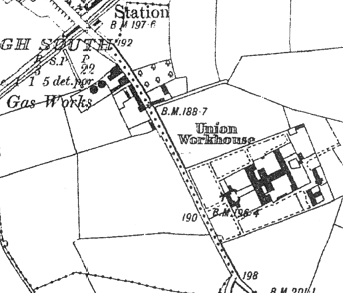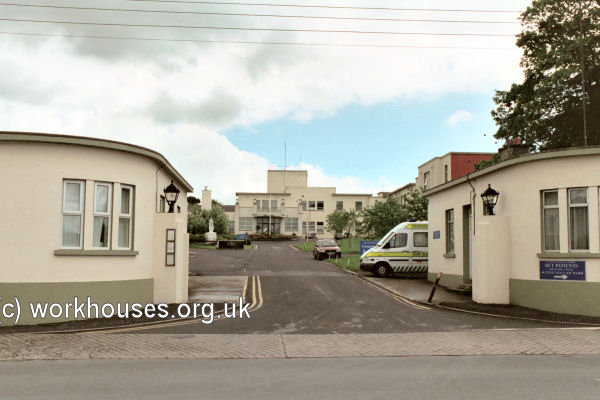Nenagh, Co. Tipperary
Nenagh Poor Law Union was formally declared on the 9th February 1839 and covered an area of 288 square miles. Its operation was overseen by an elected Board of Guardians, 34 in number, representing its 25 electoral divisions as listed below (figures in brackets indicate numbers of Guardians if more than one):
Co. Tipperary:
Annameadle (2), Ardcrony, Ballingarry, Ballymackey, Burgessbeg, Borrisokane, Castletown (2), Cloghprior, Cloughjordan (2), Dolla, Kilbarron, Kilcomenty, Killoscully, Kilmastulla, Kilmore (2), Kilnerath, Kilruane, Knigh, Lisbunny (2), Nenagh (3), Newport, Templederry, Templekelly (2), Terryglass, Youghall (2).
The Board also included 11 ex-officio Guardians, making a total of 45. The Guardians met on Thursdays at noon.
The population falling within the Union at the 1831 census had been 89,891 with divisions ranging in size from Knigh (population 1,447) to Nenagh itself (9,842).
The new Nenagh Union workhouse was erected on a seven-acre site half a mile to the south of Nenagh. Designed by the Poor Law Commissioners' architect George Wilkinson, the building was based on one of his standard plans to accommodate 1,000 inmates. Its construction cost £8,320 plus £1,580 for fittings etc. The workhouse was declared fit for the reception of paupers on 1st December 1841, and received its first admissions on 28th April 1842.
The site location and layout of the Nenagh workhouse are shown on the 1904 map below

Nenagh workhouse site, 1904.
The main buildings followed Wilkinson's typical layout. An entrance and administrative block at the west contained a porter's room and waiting room at the centre with the Guardians' board room on the first floor above.
The main accommodation block had the Master's quarters at the centre, with male and female wings to each side. At the rear, a range of single-storey utility rooms such as bakehouse and washhouse connected through to the infirmary and idiots' wards via a central spine containing the chapel and dining-hall.
During the famine in the mid-1840s, sheds and sleeping galleries were erected to accommodate an additional 260 inmates. In 1847, a 70-bed fever hospital was erected at the east of the site.
In 1853, the northern part of the Nenagh Union went to become part of the new Borrisokane Union.
At a meeting of the Nenagh Board of Guardians in December 1872, the clerk read the following report from the Master’s book:"
Signed, John Ryan, Fitzwilliam Welsh.
In reference to the soup, Mr Welsh remarked that some of the paupers said it was nothing but salt and water; more said it was very bad, and others that it was good; then in came the master, when they all said the soup was good.
Mrs Walsh happened to be present at the time, and some of the paupers called her aside and told her that they were in dread of the master to say the soup was bad before.
Mr Ryan — "There are some paupers in the house that would complain if they got champagne or turtle soup. I never saw anything better than the beef yesterday. I never saw a better dinner of the kind."
Mr Head — "I do not think any man in the land sat down to a better beef dinner."
After some conversation about keeping occasional fires in the empty rooms of the fever hospital, Mr Welsh suggested the propriety of appointing a committee to examine the soup at unexpected intervals.
Mr Poe said a Visiting Committee had been already appointed, who could come in at any time.
It was remarked that the committee alluded to by Mr Poe had not attended for the last ten months.
Mr Walsh — "There is no use in appointing a committee if they do not attend."
Mr Poe said whenever he went through the House there was not any complaints about the soup. His opinion was that there was more attention paid to the comforts of the paupers at Nenagh than in many workhouses in Ireland. The guardians were well aware that the paupers were always ready to growl and complain; and if the soup was bad they would not wait till Christmas Day to complain of it.
Mr Ryan — "If there was one ounce of bread short you would soon see what a row they would kick up."
Mr Poe suggested that two guardians be appointed to come in occasionally to inspect the soup, and that Mr Welsh be one of them.
In reply to Mr Head, the master said the soup was made of beef, meal, onions and pepper. They did not vary it.
Mr Head remarked that the beef now sent in was really good.
The workhouse buildings were burnt down by republican forces in February 1923. The Nenagh Guardian of 10th February reported:
On last Tuesday morning, about one o’clock a.m., a large number of armed men descended upon the Nenagh Workhouse buildings. They roused up the master, Mr E. M. Flannery, the nuns and other members of the staff and apparently indicated their intention to burn the buildings — known as the "Body of the House".
In this portion are housed all the old and infirm and other men and other hospital cases. They were all ordered to get up and were removed to the infirmary portion of the establishment.
All the large wing, running behind parallel to the Boardroom and clerk’s office, with the two large side wings running directly backward, together with a centre block connecting the main portion to the chapel, were then plentifully sprinkled with paraffin and petrol and set on fire.
Armed guards had been placed around the buildings and no one was allowed to leave to give the alarm. The fire burned fiercely for a couple of hours. The National troops did not observe the fire until between 5 and 6 in the morning. They were immediately called out, and the first intimation residents in the town had of anything being wrong was sound of the troops running down the street accompanied by the armoured car.
As they were coming down town one of the inmates was on the way up to give the alarm. Many of the soldiers, in addition to arms, brought buckets, too.
They were quickly on the scene and all effort was immediately concentrated on preventing the spread of the flames and saving what was possible of the buildings. The roof of the centre building was cut down and the flames thereby prevented reaching the chapel. Any hope of saving the main centre buildings, including the body of the house — male and female apartments — with the dining hall and master’s office and apartments, was out of the question and the fire had to burn itself out. All the interior woodwork and fittings were utterly destroyed but the walls are intact and do not seem much damaged.
The local fire engine was put to work, but from the beginning the fire fighters found the greatest difficulty in lack of water. In fact, water had to be carted in watering carts to the buildings to add to the supply on the spot. After several hours hard work, the fire was eventually got under control.
During the forenoon of Tuesday, soldiers were on guard at the gates and around the buildings and admission was controlled. During the day large numbers visited the ruined premises and closely inspected the wreckage.
On roads leading from Nenagh to Tyone and Ballygraigue directions stone walls were built, doubtless with the intention of preventing pursuit by lorries, etc.
The auditor, Miss O’Farrell, was engaged with the audit of the Union accounts during the week. The day after the burning she was able to "carry on as usual", as the clerk’s office was intact and official records and books undisturbed.
Fr O’Halloran, C.C., at the Men’s Confraternity on Tuesday night, referred in very strong terms to the burnings.
Some people are saying that their last refuge is gone in the burning of the workhouse; that if the present wave of destruction continues many will be driven to the workhouse in the end, and now there is no workhouse to go to!
Nenagh General Hospital (St Joseph's) now occupies the site.

Nenagh former workhouse site entrance, 2002
© Peter Higginbotham.
Records
Note: many repositories impose a closure period of up to 100 years for records identifying individuals. Before travelling a long distance, always check that the records you want to consult will be available.
- Tipperary Studies, The Source, Cathedral Street, Thurles, Co. Tipperary.
Bibliography
Links
- None.
Unless otherwise indicated, this page () is copyright Peter Higginbotham. Contents may not be reproduced without permission.


